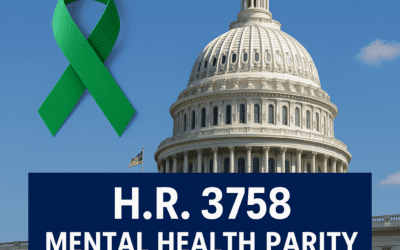The civil rights movement made the abolition of all forms of discrimination a matter of public policy. Notwithstanding the tremendous strides that have been made to redress discrimination of all types, one group that continues to be subjected to long-standing stigmatization and social isolation are those who suffer from mental illness.
The high watermark of legislation to end discrimination against mental illness was the passage of the Mental Health Par it y and Addiction Equity Act [ l ] in 2008. That law bars health insurers from offering unequal benefits for treatment of behavioral health conditions than are provided for medical or surgical treatment.
The Parity Act is limited to health insurance, though; and discrimination against mental illness has persisted and even expanded in recent years in relation to disability insurance. Almost all group long-term disability insurance policies and a growing number of individual disability income policies flagrantly discriminate against those who suffer from psychiatric impairments by arbitrarily imposing limits on the benefits payable under those policies.
While claimants with chronic physical impairments are eligible to receive disability payments until they reach age 65 or Social Security norm al retirement age, disability plans cut off benefit payments for sufferers of mental illness after 12 or 24 months regardless of whether their conditions have improved sufficiently to allow them to return to work.
Besides being discriminatory, there is no apparent legitimate medical or actuarial reason for offering inferior disability benefits to claimant s who suffer from mental illness. Years ago, when such limitations were first adopted, there was no standardization of diagnostic criteria, limited validated psychometric testing, and few effective medications, so almost all claims were chronic and insurers had difficulty evaluating the legitimacy of claims. All of that has changed.
The mental health profession in the U.S. now universally uses the Diagnostic and Statistical Manual of Mental Disorders [ 2] to classify psychiatric conditions; effective medications with fewer side effects have been developed; and standardized psychometric testing can now objectively assess psychopathology.
Work absences due to mental illness have also become shorter; thus, the duration of a disability claim due to psychiatric conditions has been reduced.[ 3] Moreover, mental health conditions make up such a small percentage of both short-term and long-term disability claims[ 4 ] that their impact on the overall volume of disability claims, while not insignificant, is not nearly as costly as disability due to musculoskeletal impairments.
The financial disruption caused by disability is devastating and is a leading factor in consumer (individual) bankruptcies in America.[5] The financial consequences of disability are no less severe for those who have psychiatric conditions, though. And if disability payment s are arbitrarily withdrawn due to policy limitations for mental illness, claimants who suffer from behavioral health disorders generally lack the necessary financial resources to maintain insurance coverage for ongoing treatment that could restore them to health, and may require public assistance.
Allowing insurers to discriminate against mental illness also creates an opportunity for questionable practices. Many medical conditions are difficult to diagnose and may be initially viewed as psychosomatic. In other situations, claimants may develop depression or anxiety as a result of chronic physical illness. In such cases, claimants are at risk of having their benefits disrupted if their disability insurer classifies the disabling impairment as psychiatric.
Further, while some policies list exceptions to the mental illness limitation for conditions such as schizophrenia, dementia and bipolar disorders, other policies have been drafted to subject any condition listed in the Diagnostic and Statistical Manual of Mental Disorders to the limitation; and that would include Alzheimer’s disease and even traumatic brain injuries.
In one notable case from 2014, Berkoben v. Aetna Life Insurance Co., a policy excepted schizophrenia, but not schizoaffective disorder from the limitation. [6] Such hairsplitting does little more than create a lottery system where lucky individuals can get paid for a longer duration while the unlucky see their benefits prematurely disrupted before they have had adequate time to recover.
Although disability due to mental illness affects a small number of the overall universe of disability claims, the incidence of disability in the U.S. is shockingly high. The Council for Disability Awareness repo rt s: “More than one in four of today ‘s 20-year-olds can expect to be out of work for at least a year because of a disabling condition before they reach the normal retirement age. “[ 7] However, the picture is not entirely dire.
A story that aired on National Public Radio reported the average duration for all long-term disability claims is 34.6 months, thus suggesting the cost of disability insurance payments can be controlled.[8] To qualify for and remain on benefits, insureds need to meet rigorous proof requirements such as providing imaging and laboratory test results to corroborate their treating doctors’ findings.
Since the quality of psychometric testing and the ability of such testing to detect deception has markedly improved over time, claimants suffering from psychiatric illness are no less able than those with physical impairments to meet the proof requirements necessary to establish their ongoing impairment.
Since the practice of discriminating against those who suffer from mental illness began well before I started practicing law in the 1980s, the industry is fighting a rearguard action contrary to public policy to maintain their right to discriminate. The Social Security Administration has always treated mental and physical disabilities equally.
Other countries such as Canada have also made it unlawful to discriminate against mental illness in disability insurance, finding such a practice contrary to their provincial human rights laws.[9] A flurry of litigation in the U.S. tried to overturn the inequality between physical and psychiatric disability benefit s under the Americans with Disabilities Act,[10] but such litigation failed after multiple courts of appeals determined that the ADA does not apply to former employees; nor does it regulate the content of insurance policies. [ 11 ]
The state of Vermont also issued an administrative ban on discrimination against mental health conditions in 2008. [ 12] The cited basis for taking such action without legislation were state statutes protecting consumers against unfair and unconscionable practices, as well as the authority granted to the state insurance director to prohibit unjust and unfair policy terms.[13]
Another state effort to ban the discriminatory practice was Montana’s inclusion of disability insurance and disability income insurance in its state mental health parity law, as recounted in Sand-Smith v. Liberty Life Assurance Co. of Boston.[14] There, the U.S. District Court for the District of Montana rejected a challenge to the Montana law on preemption grounds under that Employee Retirement Income Security Act. Unfortunately for potential disability claimants in Montana, the state mental health parity law was subsequently amended and no longer app lies to disability insurance.
To be sure, there would need to be actuarial adjustments to disability insurance policies that are issued without limitations for psychiatric disabilities and the premium costs would almost certainly be impacted. The precise amount of a potential increase in premiums is unknown though without access to proprietary actuarial data from the various disability insurers.
However, since we have already crossed that Rubicon by mandating mental health parity in health insurance, prevention of the economic and societal harm that result from the unequal treatment of disabilities due to mental health disability more than justifies the need for expanding mental health parity in disability insurance.
Relatedly, another commonly advanced justification for maintaining the status quo is concern that employers might be dissuaded from offering disability insurance if the costs went up due to a mandate to provide mental health parity. That argument is absurd since employers offer benefits as a means of recruiting and retaining highly qualified employees.
An employer that stopped offering disability insurance to its employees would soon find it more difficult to hire new employees and would see their workforce dwindle if employees could find a better benefit package at a competing employer. Moreover, in many instances, disability benefit plans are designed to provide tax-free benefits by having the employee pay the premium costs with post-tax dollars, so concerns that employers would stop offering disability insurance are unwarranted.
The Sand-Smith case also eliminates yet another concern that state initiatives to mandate mental health parity in disability insurance would be futile due to preemption concerns under the ERISA. As that case found, laws that regulate insurance and the content of insurance policies are exempt from ERISA preemption.[15]
That leaves only one remaining objection to imposing mental health parity requirements in disability insurance – it may impact insurers’ profits. Eliminating discrimination against the mentally ill and providing them with equal coverage that ensures their economic well-being if they suffer a disabling psychiatric condition should easily outweigh such concerns especially since the marketplace will allow insurers to make up the difference elsewhere.
The time has come to end discrimination against mental illness in disability insurance and expand mental health parity laws to outlaw such discrimination in the same manner that Congress and the various state legislatures have acted to end mental illness discrimination in health insurance.
Mark DeBofsky is a shareholder at DeBofsky Law.
This article was originally published in Law360 on May 11, 2020 https://www.law360.com/articles/1270173
The opinions expressed are those of the author(s) and do not necessarily reflect the views of the firm, its clients, or Portfolio Media Inc., or any of its or their respective affiliates. This article is for general information purposes and is not intended to be and should not be taken as legal advice.
[ 1] 29 U.S.C. § 1985a.
[ 2] American Psychiatric Association: Diagnostic and Statistical Manual of Mental Disorders: Diagnostic and Statistical Manual of Mental Disorders, Fifth Edition. Arlington, VA: American Psychiatric Association, 2013.
[ 3] A leading disability insurer reports that the average period of absence from work is 59 days and mental health conditions are nearly twice the average. https ://www.standa r d.com/ employer/ employee-disability- leave-study.
[ 4] The Council for Disability Awareness reports that psych iatric claims make up 7.7% of all short-term disability claims and only 9.1% of long-term disability claims https://disabilityca n happen. org/ disability-statistic/ .
[ 5] Id.
[ 6 ] Berkoben v. Aetna Life Ins.Co., 8 F.Supp.3d 689 (W.D.Pa. 2014)
[ 7] See fn. 4.
[ 8] Andrews, “Why a Long-Term Disability Policy is More Important than Pet Insurance,” National Public Radio October 11, 2017.
[ 9] Battlefords and District Co-operative v. Gibbs, [1996] 3 SCR 556 (Supreme Court of Canada); Brooks v. Canada Safeway , Ltd., [ 1989] 1 SCR 1219 (Supreme Court of Canada).
[ 10] 42 U.S.C. § 12101 et seq.
[ 11] See, e.g., Weyer v. Twentieth Century Fox Film Corp., 198 F.3d 1104 (9th Cir. 2000). [ 12] State of Vermont, Department of Banking, Insurance, Securities and Health Care Administration, “Revised HCA Bulletin 127: Discrimination Against Disability Due to a Mental Health Condition Prohibited in Disability Income Replacement Insurance,” (October 22, 2008) (available at https:/ / www.google.com/ url?sa=t&rct=j&q =&esrc=s&source= web&cd = 2&cad = rja&uact=8&ved=2ahUKEwi379LS9pXpAhX XVc0KHYj3Al YQFjABegQIAhAB&url=https%3A%2F%2Fdfr. vermont.gov% 2Fsites% 2Ffinreg% 2Ffiles% 2Fregbul% 2Fdfr -bullet in-health-127.pdf&u sg= AOvVaw2RFMcDxelLQJwnwdpZxR-I ) . [ 1 3] 8 VSA §§ 10 , 4062.
[ 14] 2017 WL 41689430 (D. Mont. September 20, 2017).
[ 15] The ERISA “savings clause” exempts from preemption laws that regulate insurance. 29
U.S.C. § 11 44( b)( 2).






